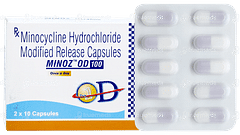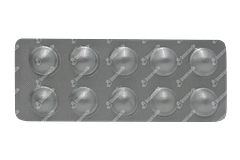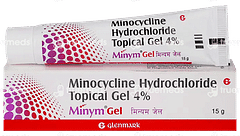Minocycline
Uses of Minocycline
The primary use of Minocycline is to treat various bacterial infections. It belongs to the group of broad-spectrum tetracycline antibiotics.
The secondary uses of Minocycline include managing respiratory tract infections such as pneumonia, bronchitis, and sinusitis, urinary tract infections, sexually transmitted infections like gonorrhoea, chlamydia, and syphilis, skin infections such as severe acne, rosacea, and perioral dermatitis, rickettsial infections like Rocky Mountain spotted fever and typhus fever, Lyme disease, H. pylori peptic ulcers, periodontal disease, and leprosy. It is also sometimes used off-label for managing symptoms of rheumatoid arthritis.
Side effects of Minocycline
Nausea
Vomiting
Diarrhoea
Dizziness
Skin rash
How Minocycline works
Minocycline is a broad-spectrum antibiotic of the tetracycline category.
It functions by penetrating bacterial cells and temporarily attaching itself to the 30S subunit of ribosomes. This process blocks the linking of aminoacyl-tRNA to the mRNA-ribosome complex, thereby impeding bacterial protein synthesis. While its primary action is bacteriostatic, meaning it prevents bacteria from multiplying, Minocycline can also kill bacteria at higher concentrations. Its potency extends to a wide variety of microorganisms, including both gram-positive and gram-negative bacteria, some unusual organisms, and certain protozoa.
Certified content
Written By

Doctor of Medicine
Reviewed By

BMS, FMC, MD Resident
Expert Advice
Dosage Forms Available
Minocycline is available in various dosage forms for administration via different routes. It can be consumed orally (capsules, tablets and oral suspension).
It is also available in injection form and can be administered intravenously (IV) by a healthcare professional.
Age and Dose Restrictions
Minocycline is prescribed for both adults and children; however, it should generally be avoided in children under 8 years of age, as it can cause permanent tooth staining. It may only be used in young children for specific conditions, such as inhalational anthrax, or when a doctor determines it is necessary.
Contraindications
Minocycline is contraindicated in individuals who have shown hypersensitivity to tetracyclines in the past. This medication should be used with caution in patients with liver or kidney impairment, as dose adjustments may be necessary.
Other Medications to Avoid
Minocycline may interact with antacids (such as aluminium hydroxide and magnesium carbonate), iron supplements (like ferrous sulphate), calcium supplements (like calcium carbonate), retinoids (such as isotretinoin) and anti-ulcer medicines (like cimetidine).
Overdose and Missed Dose
Overdosing on Minocycline may lead to serious symptoms, including nausea, vomiting, and dizziness. If you suspect an overdose, you should seek immediate medical attention.
If you miss a dose of Minocycline, take it as soon as you remember. However, if it is nearly time for your next dose, skip the missed dose and continue with your regular schedule.
Management of Side Effects
Most side effects are temporary and generally harmless and resolve when discontinuing this medicine. However, if you experience any severe side effects or worsening of any of the symptoms, please consult your doctor.
To manage gastrointestinal side effects like nausea, taking the medicine after meals might help.
Sipping on water throughout the day can relieve dry mouth, which is another common side effect.
Use in Driving and Operating Machinery
Minocycline may cause dizziness or drowsiness in some individuals. If you experience these symptoms, it is advisable to avoid driving or operating heavy machinery.
Use in Pregnancy and Lactation
Minocycline can cause harm to the foetus when administered to a pregnant woman. It should only be used during pregnancy if the potential benefits outweigh the risks.
As this medicine crosses into breast milk, alternate antibiotics are preferred during breastfeeding.
Caution in Other Conditions
Patients with liver or kidney disease should exercise caution when taking Minocycline, as dose adjustments may be necessary. It should also be used with caution in patients with myasthenia gravis (a chronic autoimmune neuromuscular disease) as it may worsen muscle weakness.
Special Dietary and Lifestyle Recommendations
Dairy products, antacids, and iron supplements should be avoided within two to three hours of taking a dose, as they can interfere with absorption.
Sun exposure should be minimised during treatment with Minocycline as it may cause photosensitivity reactions. When going outdoors, wearing protective clothing and applying sunscreen with a high SPF can help prevent burns.
Frequently asked questions
Can Minocycline lead to secondary infections?
Long-term use of Minocycline may lead to secondary infections like oral or vaginal candidiasis or C. difficile colitis.
Does Minocycline interfere with contraceptive pills?
Yes, Minocycline can interfere with the effectiveness of contraceptive pills by speeding up the breakdown of estrogens.
Can I take painkillers with Minocycline?
While over-the-counter pain relievers like paracetamol can be safely taken with Minocycline, NSAIDs like ibuprofen and naproxen should be avoided as they may increase the risk of adverse effects.
Is Minocycline a steroid?
No, Minocycline is not a steroid. It is a tetracycline antibiotic that is used to manage a wide range of bacterial infections.
Does Minocycline have any effect on sleep?
Minocycline is not directly associated with affecting sleep. However, if you experience sleep disturbances after taking this medicine, you should report it to your doctor.
Is it safe to take Minocycline daily?
Yes, it is safe to take Minocycline daily as long as it is taken in the dose and duration prescribed by your doctor. Always follow your doctor's specific instructions for use.
How much time does Minocycline take to work?
Minocycline begins working soon after administration, but effects may not be clinically apparent for 48-72 hours. Improvement is usually seen within 1-2 weeks.








Subscribe
Claim your complimentary health and fitness tips subscription and stay updated on our newest promotions.
Download Truemeds
Manage your health with ease Download Truemeds today!Get easy access to medicine refills, health information, and more. With our app, you'll never have to wait in line again. Download now and start taking control of your health.

Contact Us
Our customer representative team is available 7 days a week from 9 am - 9 pm.
v3.4.16
Our Payment Partners








